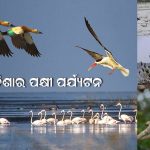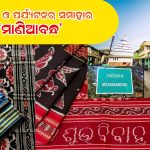We all cherish preserving our heritage. As Odias, we take immense pride in our rich legacy, which includes ancient temples, manuscripts, monuments, music, dance forms, handlooms and handicrafts.
In this blog we will talk about the handlooms of Odisha. Our handlooms have a distinct identity of their own. Woven with utmost precision and skill, they feature intricate patterns, geometric designs, elements of nature, and temple designs that are a treat for the eyes!
Our handlooms play a significant role in supplementing the economy of Odisha,and boosting its image on a national and global level. Today we will discuss the authentic handlooms of Odisha which have received the Geographical Indication (GI) tag by the government of India.This recognition not only highlights the uniqueness and authenticity of Odisha’s handloom products but also honors the traditional craftsmanship and cultural significance embedded in each piece.
Odisha Ikat
If you love exploring hand-woven things, Odisha’s Ikat saree and fabric should be first in your bucket list. It received its GI status in the year 2006. Often referred to as ‘the Poetry on the Looms’, Ikat handlooms and fabric have captured the hearts of millions for their unmatched grace.
The weavers from the Bhulia and Meher communities have mastered the technique of waving the Ikat. The weavers incorporate vibrant colors with intricate motives, using the resist-dyeing technique, in which the patterns are dyed and bound in threads to create the design on the loom before weaving. The primary colors that the sarees are red, black, white, and green.
The silk fabric which is woven in Nuapatna features hymns from Gita Gobinda, apart from the beautiful motifs of flowers, temple towers, etc. The deities of the Jagannath temple are wrapped in the fabric.
Khandua Saree & Fabrics
If you have an unparalleled love for handlooms, you must know about Khandua sarees.
Also referred to as ‘Kataki’, these sarees have their roots in Cuttack, created by the communities from Maniabandha and Nuapatna. They are traditionally red, yellow, maroon, and cream in colour. Historically, these sarees have a close link with Lord Jagannath. As the ritual demands, the Lord is wrapped in the sarees. Just like the Ikat sarees, these sarees also contain texts from Gita Gobinda
You will also find designs of lions, peacocks, chakra, lotus, swans, etc., in these magnificent sarees.They were conferred the Geographical Indication (GI) tag by the government in 2010.
Gopalpur Tussar Fabric
Every saree in Odisha has its own set of skilled weavers who bring out the elegance in the best way. Another such finest example is the Gopalpur Tussar Fabric.
Over 400 years old, Tussar fabric belongs to Gopalpur village in Jajpur, and is said to have an age-old connection with Sri Chaitanya. These sarees are designed using the special extra-weft technique by the weavers, who incorporate hand-spun and hand-reeled yarns. What differentiates this saree from the rest is its coarse texture and a golden glaze added to it.
It received the GI tag in 2009.
Sambalpuri Bandha Saree and Fabrics
Rich in heritage and culture, Sambalpur is one of the shining gems of Odisha. Talk about its music, dance, and scenic beauty, Sambalpur shines in every aspect. Similarly, Sambalpuri handlooms are also much sought after.
Originating from the land of Maa Samlei, Sambalpuri handlooms have a pristine look. Special tie and dye techniques and vibrant colors give them a different kind of glaze. Numerous motifs like oats, wheels, fish, leaves, conch, etc adore these sarees. Did you know, that our late Prime Minister Indira Gandhi loved wearing Sambalpuri sarees often? Infact, she played a huge role in popularizing the Sambalpuri sarees.
Kotpad Saree and Fabrics
One of the masterpieces woven by our tribals, our Kotpad sarees deserve to be celebrated!
From the tribal city of Koraput, the Kotpad fabric has a distinct identity. The tribals of the Mirgan community weave these sarees. It was the first item from the state to receive the GI tag, in the year 2005. One of the distinct features of this saree is that the weavers use organic colors to give a unique look to the saree. On the top of it, the alluring motifs and patterns add to the look and the grace of these sarees.
Bomkai Saree & Fabrics
Proceeding further, we have the classy Bomkai saree and fabric on the list.
One of the favorites of every handloom lover, these sarees are known for their heavy-contrast borders and heavy pallu. These unique sarees trace their origin to Ganjam and received their GI status in the year 2012. The artisans incorporate elaborate designs, such as fish, tortoise, and temple designs. However, the buty and the temple designs on the sarees are their most common features.
Habaspuri Saree and Fabrics
Featuring on this list is another hand-woven wonder- Habaspuri sarees and fabric.
Woven by the Bhulia community of Odisha, Habaspuri fabric is one of the 14 geographical indications of Odisha. It was originally woven by the Kandha tribe during the 19th century. It received GI tag in 2012. The sarees are woven using the famous tye and dye technique, whose motifs are inspired by nature, such as fish, flowers, and Kumbha(Temple designs).
Berhampur Phoda Kumbha Saree
Last but not least, we have the Berhampuri saree on the list, which got the GI tag from the government of India in 2013.
Particularly known for its attractive kumbha design, particularly the PhodaKumbha(temple-type design), the saree was introduced in Berhampur, the ‘Silk City’ of Odisha by the Mohuri kings in 14th century A.D. These sarees earned popularity and were exported to Southeast Asia and other countries through Gopalpur port.
So,which among these handlooms is your favourite? Do share your answers in the comment box below!
To read more such interesting blogs on Odisha and its vibrant culture, visit our website, www.odiasamaj.org and keep following us on our social media pages.
About the Author:
Charupadma Pati is a senior content and copywriter at Sanket Communications. She loves reading books on fiction genre. Writing poetry is her passion.
We all cherish preserving our heritage. As Odias, we take immense pride in our rich legacy, which includes ancient temples, manuscripts, monuments, music, dance forms, handlooms and handicrafts.
In this blog we will talk about the handlooms of Odisha. Our handlooms have a distinct identity of their own. Woven with utmost precision and skill, they feature intricate patterns, geometric designs, elements of nature, and temple designs that are a treat for the eyes!
Our handlooms play a significant role in supplementing the economy of Odisha,and boosting its image on a national and global level. Today we will discuss the authentic handlooms of Odisha which have received the Geographical Indication (GI) tag by the government of India.This recognition not only highlights the uniqueness and authenticity of Odisha’s handloom products but also honors the traditional craftsmanship and cultural significance embedded in each piece.
Odisha Ikat
If you love exploring hand-woven things, Odisha’s Ikat saree and fabric should be first in your bucket list. It received its GI status in the year 2006. Often referred to as ‘the Poetry on the Looms’, Ikat handlooms and fabric have captured the hearts of millions for their unmatched grace.
The weavers from the Bhulia and Meher communities have mastered the technique of waving the Ikat. The weavers incorporate vibrant colors with intricate motives, using the resist-dyeing technique, in which the patterns are dyed and bound in threads to create the design on the loom before weaving. The primary colors that the sarees are red, black, white, and green.
The silk fabric which is woven in Nuapatna features hymns from Gita Gobinda, apart from the beautiful motifs of flowers, temple towers, etc. The deities of the Jagannath temple are wrapped in the fabric.
Khandua Saree & Fabrics
If you have an unparalleled love for handlooms, you must know about Khandua sarees.
Also referred to as ‘Kataki’, these sarees have their roots in Cuttack, created by the communities from Maniabandha and Nuapatna. They are traditionally red, yellow, maroon, and cream in colour. Historically, these sarees have a close link with Lord Jagannath. As the ritual demands, the Lord is wrapped in the sarees. Just like the Ikat sarees, these sarees also contain texts from Gita Gobinda
You will also find designs of lions, peacocks, chakra, lotus, swans, etc., in these magnificent sarees.They were conferred the Geographical Indication (GI) tag by the government in 2010.
Gopalpur Tussar Fabric
Every saree in Odisha has its own set of skilled weavers who bring out the elegance in the best way. Another such finest example is the Gopalpur Tussar Fabric.
Over 400 years old, Tussar fabric belongs to Gopalpur village in Jajpur, and is said to have an age-old connection with Sri Chaitanya. These sarees are designed using the special extra-weft technique by the weavers, who incorporate hand-spun and hand-reeled yarns. What differentiates this saree from the rest is its coarse texture and a golden glaze added to it.
It received the GI tag in 2009.
Sambalpuri Bandha Saree and Fabrics
Rich in heritage and culture, Sambalpur is one of the shining gems of Odisha. Talk about its music, dance, and scenic beauty, Sambalpur shines in every aspect. Similarly, Sambalpuri handlooms are also much sought after.
Originating from the land of Maa Samlei, Sambalpuri handlooms have a pristine look. Special tie and dye techniques and vibrant colors give them a different kind of glaze. Numerous motifs like oats, wheels, fish, leaves, conch, etc adore these sarees. Did you know, that our late Prime Minister Indira Gandhi loved wearing Sambalpuri sarees often? Infact, she played a huge role in popularizing the Sambalpuri sarees.
Kotpad Saree and Fabrics
One of the masterpieces woven by our tribals, our Kotpad sarees deserve to be celebrated!
From the tribal city of Koraput, the Kotpad fabric has a distinct identity. The tribals of the Mirgan community weave these sarees. It was the first item from the state to receive the GI tag, in the year 2005. One of the distinct features of this saree is that the weavers use organic colors to give a unique look to the saree. On the top of it, the alluring motifs and patterns add to the look and the grace of these sarees.
Bomkai Saree & Fabrics
Proceeding further, we have the classy Bomkai saree and fabric on the list.
One of the favorites of every handloom lover, these sarees are known for their heavy-contrast borders and heavy pallu. These unique sarees trace their origin to Ganjam and received their GI status in the year 2012. The artisans incorporate elaborate designs, such as fish, tortoise, and temple designs. However, the buty and the temple designs on the sarees are their most common features.
Habaspuri Saree and Fabrics
Featuring on this list is another hand-woven wonder- Habaspuri sarees and fabric.
Woven by the Bhulia community of Odisha, Habaspuri fabric is one of the 14 geographical indications of Odisha. It was originally woven by the Kandha tribe during the 19th century. It received GI tag in 2012. The sarees are woven using the famous tye and dye technique, whose motifs are inspired by nature, such as fish, flowers, and Kumbha(Temple designs).
Berhampur Phoda Kumbha Saree
Last but not least, we have the Berhampuri saree on the list, which got the GI tag from the government of India in 2013.
Particularly known for its attractive kumbha design, particularly the PhodaKumbha(temple-type design), the saree was introduced in Berhampur, the ‘Silk City’ of Odisha by the Mohuri kings in 14th century A.D. These sarees earned popularity and were exported to Southeast Asia and other countries through Gopalpur port.
So,which among these handlooms is your favourite? Do share your answers in the comment box below!
To read more such interesting blogs on Odisha and its vibrant culture, visit our website, www.odiasamaj.org and keep following us on our social media pages.
About the Author:
Charupadma Pati is a senior content and copywriter at Sanket Communications. She loves reading books on fiction genre. Writing poetry is her passion.




